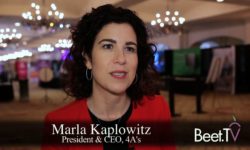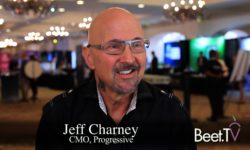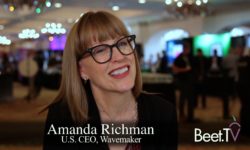ORLANDO—Driven by advances in data-driven targeting, political advertising on local cable television is soaring in advance of the mid-term elections. To FreeWheel’s Joy Baer, it’s a microcosm of what lies ahead for all advertisers.
“Emotions are running high. The good news is spend is running very high as well,” already surpassing spending in the 2016 election cycle two weeks before the mid-terms, Baer explains in this interview with Beet.TV at the recent Association of National Advertisers’ Masters of Marketing Conference. “So it’s a very exciting space.”
Behind the dollar figures are trends showing that data “is playing a really key role in enabling the right type of targeting.” Local cable’s share of political advertising budgets is at 33%, “which is an all-time high for cable advertising. We’re also seeing that their ability to go deeper into the networks that they’re selling and the candidates are buying is greater because of this data,” Baer says.
Previously, a Republican candidate might have advertised on just one TV network but now “can advertise on four or five different networks to get greater efficiency and effectiveness in reaching their audience.” The effect on Democratic candidates is even greater, with some using more than a dozen networks “because of this rich data that’s informing the buy.”
Because of the compressed time frame of political campaigns, they have been leaders in the use of data targeting, particularly with the rise of digital media. But political spending is still focused primarily on TV.
“TV is still king in many ways,” says Baer. “In large part because political spend happens between Labor Day and November. So it’s a very condensed window of time, and in order to be effective in spending what turns out to be billions of dollars in aggregate, we need to do it in an efficient medium. And television is that medium.”
Nonetheless, digital spending by political campaigns also is up to the tune of triple digits, according to Baer, citing data from Comcast Spotlight, which marries its own data insights with voter data to help better target cable advertising at the local market level.
“So there’s a greater amount of digital inventory, and actually that’s driven a lot by set-top box VOD inventory. So what we’re seeing is the trend toward accessing cross-screen and following viewership to their other devices and modeling after their viewing habits, not just live television.”
Political advertisers also are harnessing household addressable advertising for more precise targeting of voters, according to Baer, who is President of FreeWheel Advertisers (formerly STRATA).
All in all, she believes that the two-month campaign window represents an “accelerated view” of what’s happening in television.
“While TV marketing is undergoing tremendous change overall, in the context of political everything is accelerated. One trend that we’re seeing is that data-driven television is the future. I would say one of the main takeaways from the political spending season right now is that using intelligent data capabilities married with the right television inventory is going to skyrocket effectiveness for all advertisers.”
This series “Growing Brands and Driving Results,” was produced at the ANA Masters in Marketing ’18 conference in Orlando. The series is sponsored by the FreeWheel Council for Premium Video. Please find additional coverage here.






































